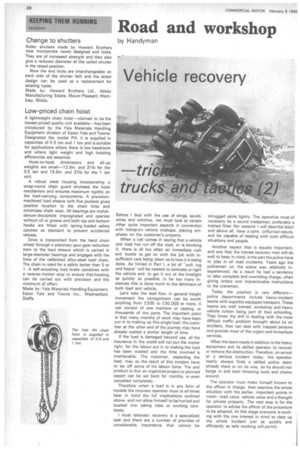Road and workshop
Page 40

If you've noticed an error in this article please click here to report it so we can fix it.
by Handyman Change to shutters
Roller shutters made by Howard Brothers now incorporate newly designed end locks. They are of increased strength and they also give a reduced diameter of the coiled shutter in the raised position.
Now the end locks are interchangeable on each side of the shutter lath and the latest design can be used as a replacement for existing types.
Made by: Howard Brothers Ltd., Abbey Manufacturing Estate, Mount Pleasant, Wembley, Middx.
Low-priced chain hoist
A lightweight chain hoist—claimed to be the lowest-priced quality unit available—has been introduced by the Yale Materials Handling Equipment division of Eaton Yale and Towne. Designated the model PH. it is supplied in capacities of 0.5 ton and 1 ton and is suitable for applications where there is low headroom and where light weight and high hoisting efficiencies are essential.
Hook-to-hook dimensions and all-up weights are small-12.5in. and 31Ib for the 0.5 ton and 15.5in. and 37Ib for the 1 ton unit.
A robust steel housing incorporating a wrap-round chain guard encloses the hoist mechanism and ensures maximum rigidity on the load-carrying components. A precisionmachined load sheave with five pockets gives positive location to the chain links and minimizes chain wear. All bearings are molybdenum-disulphide impregnated and operate without oil or grease and both top and bottom hooks are fitted with spring-loaded safety catches as standard to prevent accidental release.
Drive is transmitted from the hand chain wheel through a planetary spur-gear reduction train to the load sheave which is carried in large-diameter bearings and engages with the links of the calibrated alloy-steel load chain. The chain is rated for a safety better than 5 to 1. A self-actuating load brake combines with a reverse-motion stop to ensure that hoisting can be carried out with precision and the minimum of effort.
Made by: Yale Materials Handling Equipment, Eaton Yale and Towne Inc., Wednesfield, Staffs. Before I deal with the use of slings, spuds, wires and winches, we must look at certain other quite important aspects in connection with transport vehicle mishaps, placing emphasis on the customer's property.
When a call comes in saying that a vehicle and load has run off the road, or is blocking it, there is all too often an immediate rush and bustle to get on with the job with insufficient care being taken as to how it is being done. As hinted in Part I, a lot of "pull, tug and heave" will be needed to extricate or right the vehicle and, to get it out of the limelight as quickly as possible. In far too many instances this is done much to the detriment of both load and vehicle.
Let's take the load first; in general freight movement the consignment can be worth anything from £300 to £30,000 or more. It can consist of one machine or casting, or thousands of tiny parts. The important point is that many months of work may have been put in to making up this single load; the customer at the other end of the journey may have already waited a similar length of time.
If the load is damaged beyond use, all the insurance in the world will not put the matter right, for the labour put in to making the load has been wasted and the time involved is irretrievable. The customer, expecting the load, may as the result of this incident have to lay off some of his labour force. The end product is that an organized project or planned export can be set back for months, or even cancelled completely.
Therefore when a load is in any form of trouble the recovery operator must at all times bear in mind the full implications outlined above, and not allow himself to be hurried and bustled into taking risks or working carelessly.
I must reiterate: recovery is a specialized task and there are a number of priorities of considerable importance that cannot be shrugged aside lightly. The operative must of necessity be a sound tradesman, preferably a trained fitter (for reasons I will describe later) and above all, have a calm, unflurried nature, and be capable of dealing with both difficult situations and people.
Another aspect that is equally important, and one that the trainee recovery man will do well to keep in mind, is the part the police have to play in all road incidents. Years ago the policeman on the scene was relatively inexperienced. As a result he had a tendency to take complete and overriding charge, often giving orders and impracticable instructions to the craneman.
Today the position is very different— police departments include heavy-incident teams with superbly equipped transport. These teams are well trained, workshop and heavy vehicle tuition being part of their schooling. They know the drill in dealing with the most difficult traffic problem brought about by an accident, they can deal with trapped persons and provide most of the urgent and immediate services.
What the team needs in addition is the heavy equipment and its skilled operator to recover or remove the obstruction. Therefore, on arrival at a serious incident today, the operator nearly always finds a skilled police team already there or on its way, so he should not barge in and start throwing tools and chains around.
The operator must make himself known to the officer in charge, then examine the whole situation with the earlier, important points in mind—load value, vehicle value and a thought for private property. The next step is for the operator to advise the officer of the procedure to be adopted. At this stage everyone is working with the one interest in mind to clear up the whole incident just as quickly and efficiently as safe working will permit.




































































































